2016 NISSAN LEAF TPMS
[x] Cancel search: TPMSPage 305 of 437
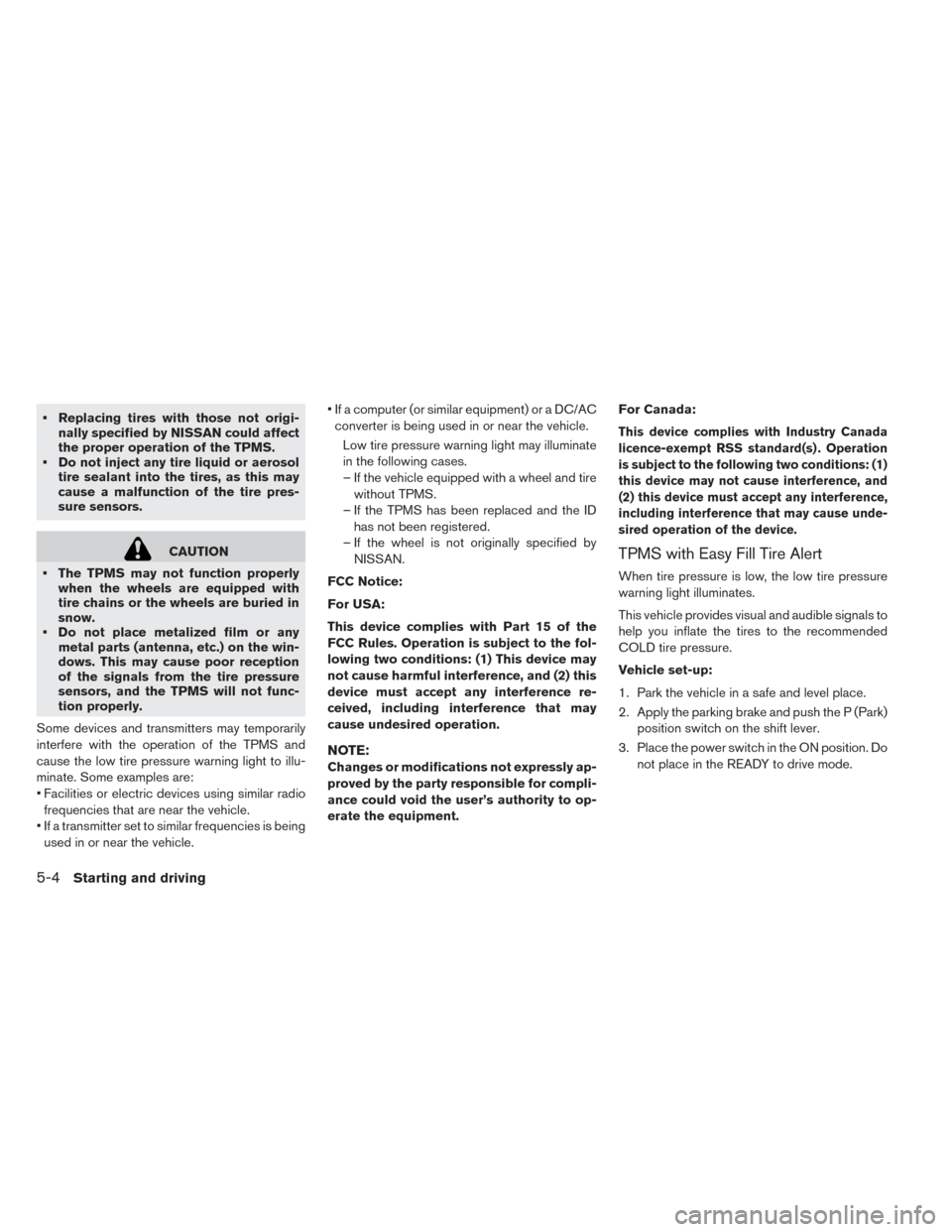
• Replacing tires with those not origi-nally specified by NISSAN could affect
the proper operation of the TPMS.
• Do not inject any tire liquid or aerosol tire sealant into the tires, as this may
cause a malfunction of the tire pres-
sure sensors.
CAUTION
• The TPMS may not function properly when the wheels are equipped with
tire chains or the wheels are buried in
snow.
• Do not place metalized film or any metal parts (antenna, etc.) on the win-
dows. This may cause poor reception
of the signals from the tire pressure
sensors, and the TPMS will not func-
tion properly.
Some devices and transmitters may temporarily
interfere with the operation of the TPMS and
cause the low tire pressure warning light to illu-
minate. Some examples are:
• Facilities or electric devices using similar radio frequencies that are near the vehicle.
• If a transmitter set to similar frequencies is being used in or near the vehicle. • If a computer (or similar equipment) or a DC/AC
converter is being used in or near the vehicle.
Low tire pressure warning light may illuminate
in the following cases.
– If the vehicle equipped with a wheel and tire without TPMS.
– If the TPMS has been replaced and the ID has not been registered.
– If the wheel is not originally specified by NISSAN.
FCC Notice:
For USA:
This device complies with Part 15 of the
FCC Rules. Operation is subject to the fol-
lowing two conditions: (1) This device may
not cause harmful interference, and (2) this
device must accept any interference re-
ceived, including interference that may
cause undesired operation.
NOTE:
Changes or modifications not expressly ap-
proved by the party responsible for compli-
ance could void the user’s authority to op-
erate the equipment. For Canada:
This device complies with Industry Canada
licence-exempt RSS standard(s) . Operation
is subject to the following two conditions: (1)
this device may not cause interference, and
(2) this device must accept any interference,
including interference that may cause unde-
sired operation of the device.
TPMS with Easy Fill Tire Alert
When tire pressure is low, the low tire pressure
warning light illuminates.
This vehicle provides visual and audible signals to
help you inflate the tires to the recommended
COLD tire pressure.
Vehicle set-up:
1. Park the vehicle in a safe and level place.
2. Apply the parking brake and push the P (Park)
position switch on the shift lever.
3. Place the power switch in the ON position. Do not place in the READY to drive mode.
5-4Starting and driving
Page 306 of 437
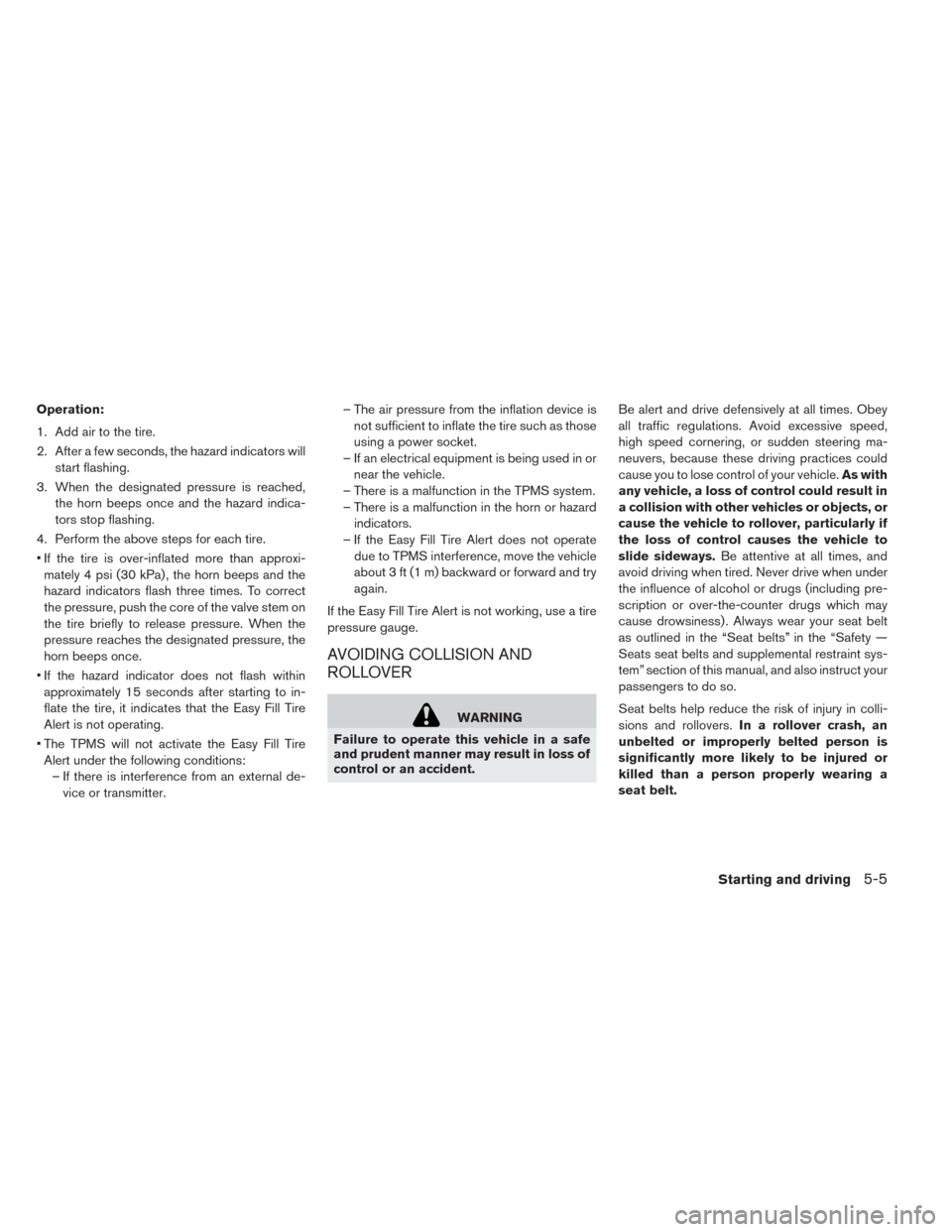
Operation:
1. Add air to the tire.
2. After a few seconds, the hazard indicators willstart flashing.
3. When the designated pressure is reached, the horn beeps once and the hazard indica-
tors stop flashing.
4. Perform the above steps for each tire.
• If the tire is over-inflated more than approxi- mately 4 psi (30 kPa) , the horn beeps and the
hazard indicators flash three times. To correct
the pressure, push the core of the valve stem on
the tire briefly to release pressure. When the
pressure reaches the designated pressure, the
horn beeps once.
• If the hazard indicator does not flash within approximately 15 seconds after starting to in-
flate the tire, it indicates that the Easy Fill Tire
Alert is not operating.
• The TPMS will not activate the Easy Fill Tire Alert under the following conditions: – If there is interference from an external de- vice or transmitter. – The air pressure from the inflation device is
not sufficient to inflate the tire such as those
using a power socket.
– If an electrical equipment is being used in or near the vehicle.
– There is a malfunction in the TPMS system.
– There is a malfunction in the horn or hazard indicators.
– If the Easy Fill Tire Alert does not operate due to TPMS interference, move the vehicle
about 3 ft (1 m) backward or forward and try
again.
If the Easy Fill Tire Alert is not working, use a tire
pressure gauge.
AVOIDING COLLISION AND
ROLLOVER
WARNING
Failure to operate this vehicle in a safe
and prudent manner may result in loss of
control or an accident. Be alert and drive defensively at all times. Obey
all traffic regulations. Avoid excessive speed,
high speed cornering, or sudden steering ma-
neuvers, because these driving practices could
cause you to lose control of your vehicle.
As with
any vehicle, a loss of control could result in
a collision with other vehicles or objects, or
cause the vehicle to rollover, particularly if
the loss of control causes the vehicle to
slide sideways. Be attentive at all times, and
avoid driving when tired. Never drive when under
the influence of alcohol or drugs (including pre-
scription or over-the-counter drugs which may
cause drowsiness) . Always wear your seat belt
as outlined in the “Seat belts” in the “Safety —
Seats seat belts and supplemental restraint sys-
tem” section of this manual, and also instruct your
passengers to do so.
Seat belts help reduce the risk of injury in colli-
sions and rollovers. In a rollover crash, an
unbelted or improperly belted person is
significantly more likely to be injured or
killed than a person properly wearing a
seat belt.
Starting and driving5-5
Page 330 of 437

6 In case of emergency
Hazard warning flasher switch...............6-2
Roadside assistance program ................6-2
Emergency EV (Electric Vehicle) shut off .........6-3
Flat tire ............................ .6-3
Tire Pressure Monitoring System (TPMS) .......6-3
Repairing flat tire .................... .6-4Jump starting
........................ .6-10
If the Li-ion battery becomes completely discharged. .6-12
Push starting ........................ .6-13
Towing your vehicle .................... .6-13
Towing recommended by NISSAN ..........6-14
Vehicle recovery (freeing a stuck vehicle) ......6-14
Page 332 of 437
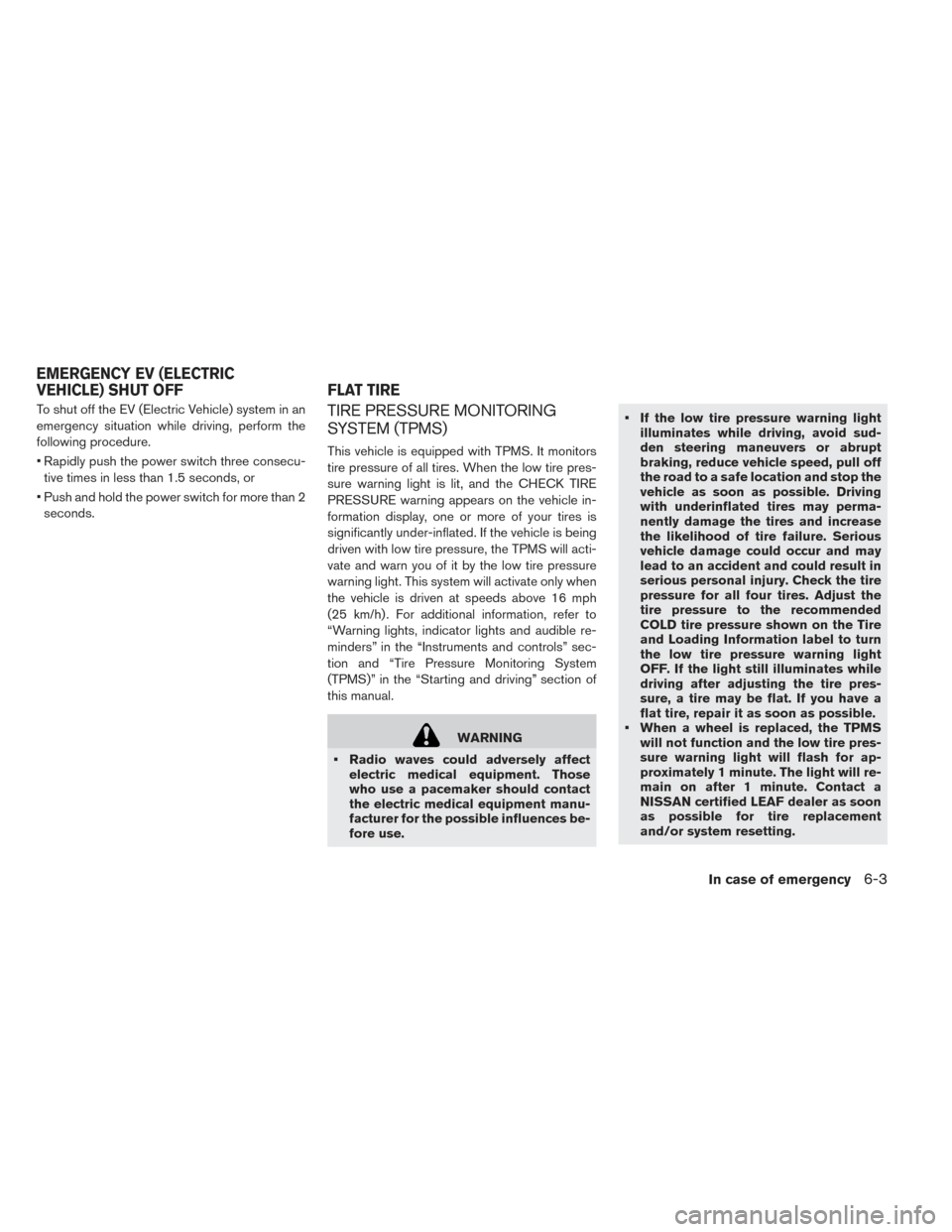
To shut off the EV (Electric Vehicle) system in an
emergency situation while driving, perform the
following procedure.
• Rapidly push the power switch three consecu-tive times in less than 1.5 seconds, or
• Push and hold the power switch for more than 2 seconds.TIRE PRESSURE MONITORING
SYSTEM (TPMS)
This vehicle is equipped with TPMS. It monitors
tire pressure of all tires. When the low tire pres-
sure warning light is lit, and the CHECK TIRE
PRESSURE warning appears on the vehicle in-
formation display, one or more of your tires is
significantly under-inflated. If the vehicle is being
driven with low tire pressure, the TPMS will acti-
vate and warn you of it by the low tire pressure
warning light. This system will activate only when
the vehicle is driven at speeds above 16 mph
(25 km/h) . For additional information, refer to
“Warning lights, indicator lights and audible re-
minders” in the “Instruments and controls” sec-
tion and “Tire Pressure Monitoring System
(TPMS)” in the “Starting and driving” section of
this manual.
WARNING
• Radio waves could adversely affect electric medical equipment. Those
who use a pacemaker should contact
the electric medical equipment manu-
facturer for the possible influences be-
fore use. • If the low tire pressure warning light
illuminates while driving, avoid sud-
den steering maneuvers or abrupt
braking, reduce vehicle speed, pull off
the road to a safe location and stop the
vehicle as soon as possible. Driving
with underinflated tires may perma-
nently damage the tires and increase
the likelihood of tire failure. Serious
vehicle damage could occur and may
lead to an accident and could result in
serious personal injury. Check the tire
pressure for all four tires. Adjust the
tire pressure to the recommended
COLD tire pressure shown on the Tire
and Loading Information label to turn
the low tire pressure warning light
OFF. If the light still illuminates while
driving after adjusting the tire pres-
sure, a tire may be flat. If you have a
flat tire, repair it as soon as possible.
• When a wheel is replaced, the TPMS will not function and the low tire pres-
sure warning light will flash for ap-
proximately 1 minute. The light will re-
main on after 1 minute. Contact a
NISSAN certified LEAF dealer as soon
as possible for tire replacement
and/or system resetting.
EMERGENCY EV (ELECTRIC
VEHICLE) SHUT OFF FLAT TIRE
In case of emergency6-3
Page 333 of 437

• Replacing tires with those not origi-nally specified by NISSAN could affect
the proper operation of the TPMS.
• The Genuine NISSAN Emergency Tire Repair Sealant or equivalent can be
used for temporarily repairing a tire.
Do not inject any other tire liquid or
aerosol tire sealant into the tires, as
this may cause a malfunction of tire
pressure sensors.
• NISSAN recommends using only NISSAN Genuine Emergency Tire Seal-
ant provided with your vehicle. Other
tire sealants may damage the valve
stem seal which can cause the tire to
lose air pressure. Contact a NISSAN
certified LEAF dealer as soon as pos-
sible after using tire repair sealant (for
models equipped with the emergency
tire puncture repair kit) .
REPAIRING FLAT TIRE
WARNING
• After using Emergency Tire Sealant to
repair a minor tire puncture, do not
drive the vehicle at speeds faster than
50 mph (80 km/h) . •
Immediately after using the Emer-
gency Tire Sealant to repair a minor
tire puncture, take your vehicle to a
NISSAN certified LEAF dealer to in-
spect, and repair or replace the tire.
The Emergency Tire Sealant cannot
permanently seal a punctured tire.
Continuing operation of the vehicle
without a permanent tire repair can
lead to a crash.
• If you used the Emergency Tire Sealant
to repair a minor tire puncture, a
NISSAN certified LEAF dealer will also
need to replace the TPMS sensor in
addition to repairing or replacing the
tire.
• NISSAN recommends using only
NISSAN Genuine Emergency Tire Seal-
ant provided with your vehicle. Other
tire sealants may damage the valve
stem seal which can cause the tire to
lose air pressure.
This vehicle does not have a spare tire. The
emergency tire puncture repair kit (Emergency
Tire Sealant) is supplied with the vehicle instead of a spare tire. It can be used to temporarily repair
minor tire punctures.
If possible, have the vehicle towed to a facility that
can repair or replace the flat tire. Using the emer-
gency tire puncture repair kit may cause a mal-
function of the tire pressure sensor and cause the
low tire pressure warning light to illuminate.
CAUTION
• To avoid the emergency tire puncture
kit being damaged during storage or
use:
–Only use the emergency tire punc-
ture repair kit on your vehicle. Do
not use it on other vehicles.
– Only use the kit to inflate the tires of
your vehicle and to check the vehi-
cle’s tire pressure.
– Only plug the compressor into a 12-
volt DC car power point.
– Keep the kit free of water and dirt.
– Do not disassemble or modify the
kit.
– Do not drop the kit or allow hard
impacts to the kit.
6-4In case of emergency
Page 339 of 437
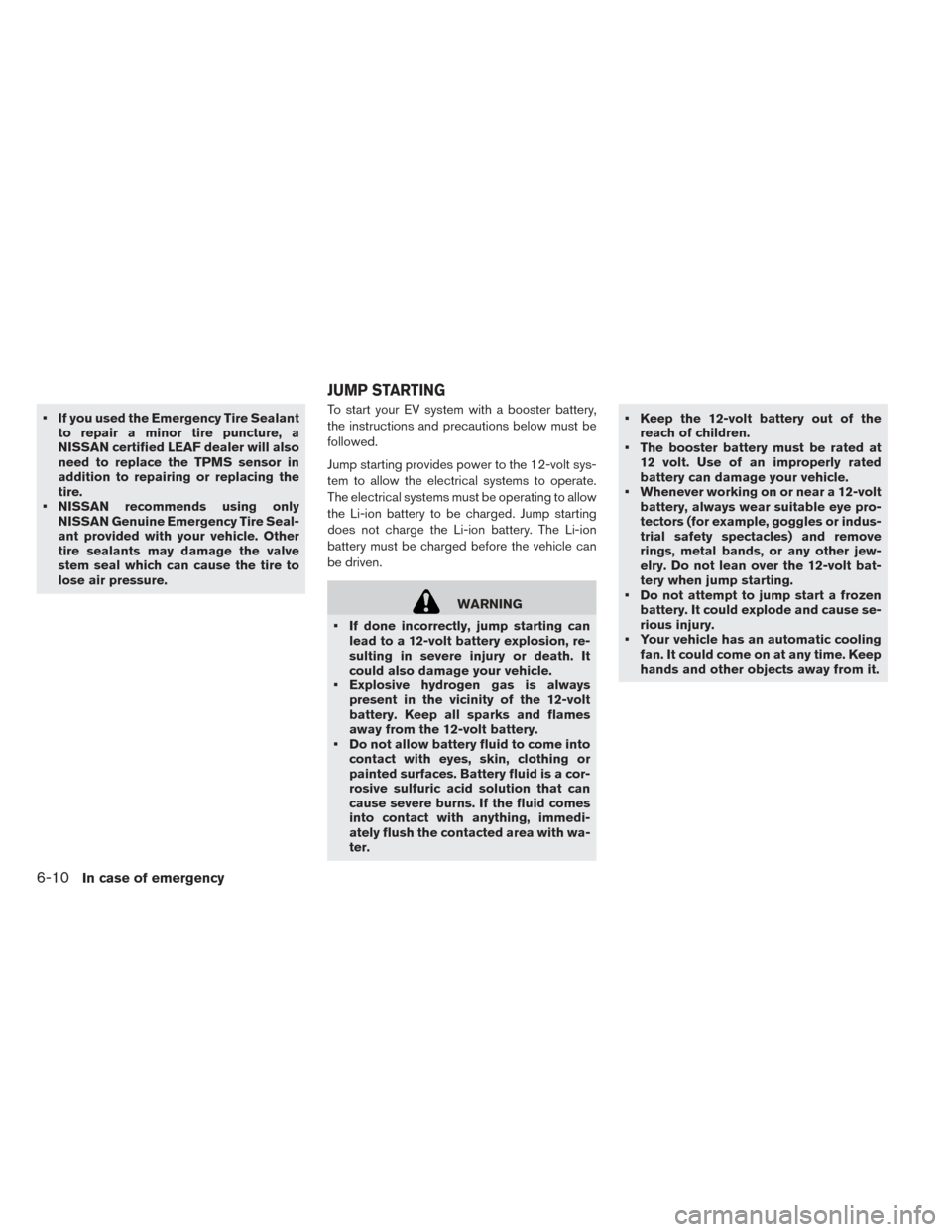
• If you used the Emergency Tire Sealantto repair a minor tire puncture, a
NISSAN certified LEAF dealer will also
need to replace the TPMS sensor in
addition to repairing or replacing the
tire.
• NISSAN recommends using only NISSAN Genuine Emergency Tire Seal-
ant provided with your vehicle. Other
tire sealants may damage the valve
stem seal which can cause the tire to
lose air pressure. To start your EV system with a booster battery,
the instructions and precautions below must be
followed.
Jump starting provides power to the 12-volt sys-
tem to allow the electrical systems to operate.
The electrical systems must be operating to allow
the Li-ion battery to be charged. Jump starting
does not charge the Li-ion battery. The Li-ion
battery must be charged before the vehicle can
be driven.
WARNING
• If done incorrectly, jump starting can lead to a 12-volt battery explosion, re-
sulting in severe injury or death. It
could also damage your vehicle.
• Explosive hydrogen gas is always present in the vicinity of the 12-volt
battery. Keep all sparks and flames
away from the 12-volt battery.
• Do not allow battery fluid to come into contact with eyes, skin, clothing or
painted surfaces. Battery fluid is a cor-
rosive sulfuric acid solution that can
cause severe burns. If the fluid comes
into contact with anything, immedi-
ately flush the contacted area with wa-
ter. • Keep the 12-volt battery out of the
reach of children.
• The booster battery must be rated at 12 volt. Use of an improperly rated
battery can damage your vehicle.
• Whenever working on or near a 12-volt battery, always wear suitable eye pro-
tectors (for example, goggles or indus-
trial safety spectacles) and remove
rings, metal bands, or any other jew-
elry. Do not lean over the 12-volt bat-
tery when jump starting.
• Do not attempt to jump start a frozen battery. It could explode and cause se-
rious injury.
• Your vehicle has an automatic cooling fan. It could come on at any time. Keep
hands and other objects away from it.
JUMP STARTING
6-10In case of emergency
Page 356 of 437

keeps the motor hood from opening when the
primary latch is released.
When driving in areas using road salt or other
corrosive materials, check lubrication frequently.
Lights*:Clean the headlights on a regular basis.
Make sure that the headlights, stop lights, tail
lights, turn signal lights and other lights are all
operating properly and installed securely. Also
check the aim of the headlights.
Road wheel nuts (lug nuts)*: When checking
the tires, make sure that no wheel nuts are miss-
ing, and check for any loose wheel nuts. Tighten
if necessary.
Tire rotation*: Tires should be rotated every
5,000 miles (8,000 km) .
Tires*: Check the pressure with a gauge often
and always prior to long distance trips. If neces-
sary, adjust the pressure in all tires to the pres-
sure specified. Check carefully for damage, cuts
or excessive wear.
Tire Pressure Monitoring System (TPMS)
transmitter components: Replace the TPMS
transmitter grommet seal, valve core and cap
when the tires are replaced due to wear or age. Wheel alignment and balance:
If the vehicle
pulls to either side while driving on a straight and
level road, or if you detect uneven or abnormal tire
wear, there may be a need for wheel alignment.
If the steering wheel or seat vibrates at normal
highway speeds, wheel balancing may be
needed.
For additional information regarding tires, refer to
“Important Tire Safety Information” (US) or “Tire
Safety Information” (Canada) in the Warranty In-
formation Booklet.
Windshield: Clean the windshield on a regular
basis. Check the windshield at least every six
months for cracks or other damage. Have a dam-
aged windshield repaired by a qualified repair
facility.
Wiper blades*: Check for cracks or wear if they
do not wipe properly.
Inside vehicle
The maintenance items listed here should be
checked on a regular basis, such as when per-
forming scheduled maintenance, cleaning the ve-
hicle, etc.
Accelerator pedal: Check the pedal for smooth
operation and make sure that the pedal does not catch or require uneven effort. Keep the floor mat
away from the pedal.
Brake pedal:
Check the pedal for smooth op-
eration. If the brake pedal suddenly goes down
further than normal, the pedal feels spongy or the
vehicle seems to take longer to stop, see a
NISSAN certified LEAF dealer immediately. Keep
the floor mat away from the pedal.
Brakes: Check that the brakes do not pull the
vehicle to one side when applied.
Electric shift P (Park) position mechanism:
On a steep hill, check that the vehicle is held
securely while the vehicle is in the P (Park) posi-
tion without applying the brakes.
Parking brake: Check the parking brake opera-
tion regularly. The vehicle should be securely held
on a steep hill with only the parking brake applied.
If the parking brake cannot keep a vehicle posi-
tion contact a NISSAN certified LEAF dealer.
Seat: Check seat position controls such as the
seat adjusters, seatback recliners, etc. to ensure
that they operate smoothly and that all latches
lock securely in every position. Check that the
head restraints/headrests move up and down
smoothly and that the locks (if so equipped) hold
securely in all latched positions.
Maintenance and do-it yourself8-3
Page 380 of 437
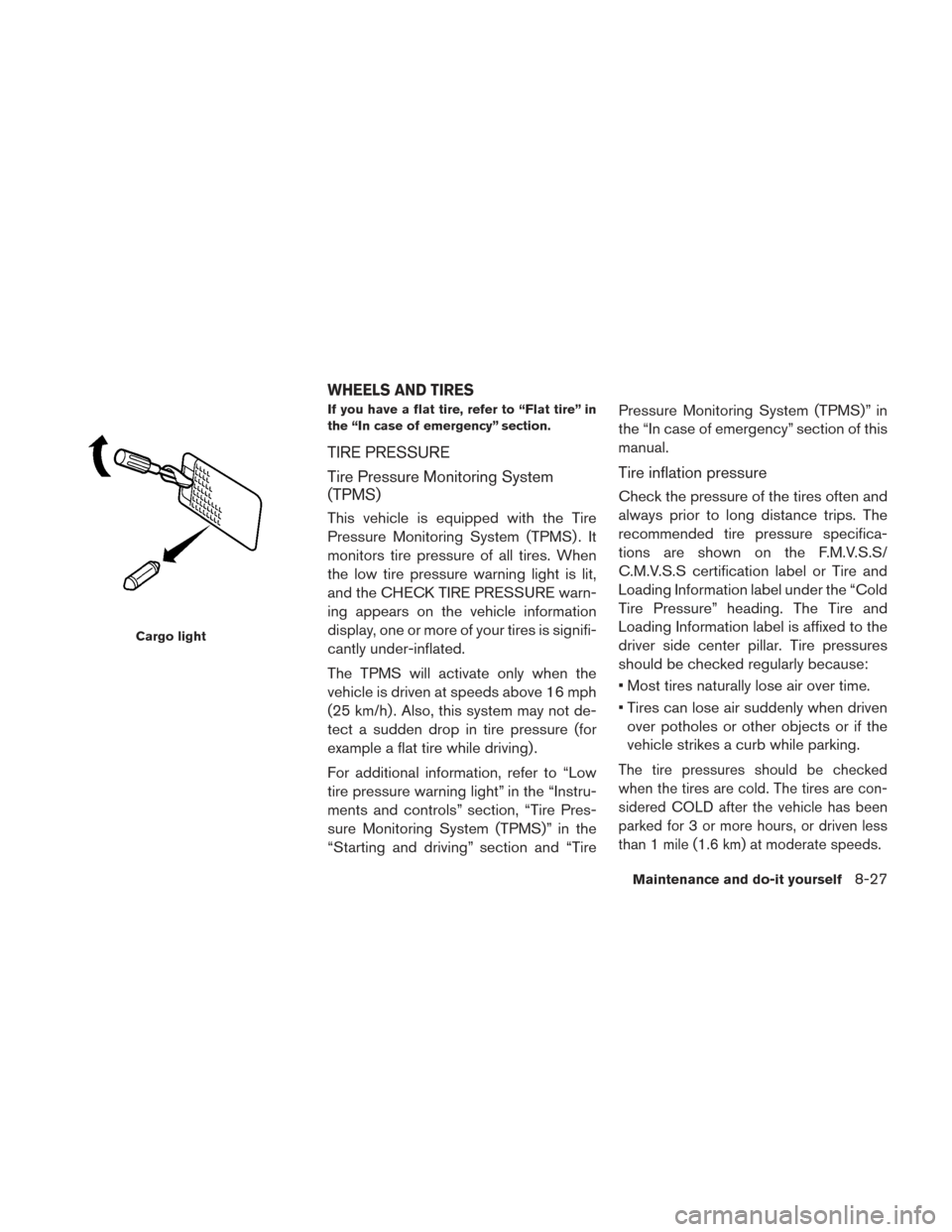
If you have a flat tire, refer to “Flat tire” in
the “In case of emergency” section.
TIRE PRESSURE
Tire Pressure Monitoring System
(TPMS)
This vehicle is equipped with the Tire
Pressure Monitoring System (TPMS) . It
monitors tire pressure of all tires. When
the low tire pressure warning light is lit,
and the CHECK TIRE PRESSURE warn-
ing appears on the vehicle information
display, one or more of your tires is signifi-
cantly under-inflated.
The TPMS will activate only when the
vehicle is driven at speeds above 16 mph
(25 km/h) . Also, this system may not de-
tect a sudden drop in tire pressure (for
example a flat tire while driving) .
For additional information, refer to “Low
tire pressure warning light” in the “Instru-
ments and controls” section, “Tire Pres-
sure Monitoring System (TPMS)” in the
“Starting and driving” section and “TirePressure Monitoring System (TPMS)” in
the “In case of emergency” section of this
manual.
Tire inflation pressure
Check the pressure of the tires often and
always prior to long distance trips. The
recommended tire pressure specifica-
tions are shown on the F.M.V.S.S/
C.M.V.S.S certification label or Tire and
Loading Information label under the “Cold
Tire Pressure” heading. The Tire and
Loading Information label is affixed to the
driver side center pillar. Tire pressures
should be checked regularly because:
• Most tires naturally lose air over time.
• Tires can lose air suddenly when driven
over potholes or other objects or if the
vehicle strikes a curb while parking.
The tire pressures should be checked
when the tires are cold. The tires are con-
sidered COLD after the vehicle has been
parked for 3 or more hours, or driven less
than 1 mile (1.6 km) at moderate speeds.
Cargo light
WHEELS AND TIRES
Maintenance and do-it yourself8-27